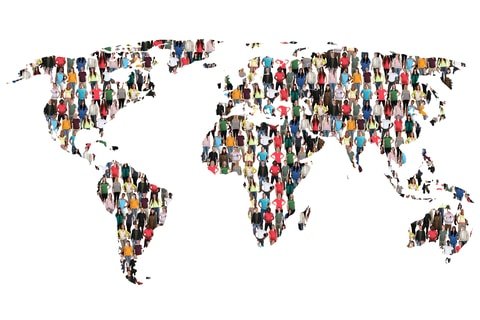‘The Future Is Gray; It Is Delayed, Small and Female’
I’ve been talking about how disruption is the new normal for some time.
Technological innovations, geopolitical crises and financial woes are forcing business and supply chain leaders to prepare for the future in different ways. From seeking profit in regionalization to navigating artificial intelligence and generative AI, we have our work cut out for us.
Add changing demographics to the list of disruptions that affect supply chain resilience.
Writing in Supply Chain Management Review, Ken Cottrill details four important demographic changes. Cottrill quotes research by Joe Coughlin, director of the MIT Center for Transportation & Logistics’ AgeLab: “The future is gray; it is delayed, small and female.”
The Future Is Older Than the Past
Globally, populations are aging. Brands, however, don’t seem to have noticed.
Coughlin told Cottrill that people older than 50 are responsible for 70% of total discretionary spending in the United States. Worldwide, those older than 60 are responsible for 30% of spending.
That’s a lot of market share. But in the United States, less than 2% to 3% of advertising dollars target older consumers.
Coughlin calls this “change blindness.”
Brands that don’t change will suffer even more in the future. Researchers expect almost half of people born since the 1990s will live at least 100 years.
In fact, by 2029, the United States is projected to have a larger population of people aged 65 and older than those younger than 18, according to the U.S. Census Bureau.
Expect the trend to continue. By 2100, the older-than-65 cohort will be nearly double the younger-than-18 cohort.
The Future Is Taking Longer to Start Playing House … and Retire
Setting up a household? Starting a family? Retiring? All three of those lifestyle decisions drive consumption, Coughlin notes.
More people, instead, are living with their parents longer and taking longer to find a significant other. Less than one-third of adults aged 18 to 29 lived with their parents in 1980. Now that estimate is 52%.
You’re talking about half of a significant population cohort not establishing households.
Older adults, for their part, are delaying retirement. As I’ve noted before, some work because they have to. Others because they still have something to contribute.
The Future World Is a Smaller World
Global birth rates have dropped 70% in 70 years. Those birth rates are not sufficient to replenish current populations in any industrialized country.
That means fewer products needed for younger age groups, fewer family homes and more single homes.
Coughlin listed a number of major cities where more than half of homes are households of one: Brussels, Oslo, Munich and Paris. American cities are following suit.
Implications are enormous. Single-person homes will buy fewer goliath-sized family portions and more single-serving items. I think big warehouse stores could suffer from the lack of large families.
The Future Is More Female
Coughlin called women “the chief consumer officer of the home.”
Women already control more than $10 trillion of U.S. financial assets. That number will triple to $30 trillion by decade’s end.
They shape demand in consumer electronics, consumer goods and healthcare.
Their education makes them more discerning buyers, Coughlin said. And much eCommerce demand comes from female buyers.
The Pew Research Center analyzed government data and found that women are more than half (50.7%) of the college-educated labor force in the U.S. And the women-to-men ratio in college has been increasing since 1980, according to the Federal Reserve.
Bite-Sized Deliveries, Healthcare at Home, Redesigned Work
Coughlin appropriately notes that these demographic changes have massive supply chain implications.
Women will work jobs traditionally held by men, which will require some redesign. Aging workforces will require more automation and less manual labor.
Brick-and-mortar will still exist, but the shopping experience will include product curation, emphasis on their novelty value and brand engagement. Younger generations likely will view store visits as a social visit. Retailers will have to create unique experiences to draw them in.
Smaller families mean smaller package sizes.
Even the nature of the home will change. Sensor-rich medical technology will help deliver healthcare services at home.
And older customers likely will require more “white glove” delivery. That means more help with installing electronics and appliances and fewer packages dropped at the doorstep.
Delivery staff will join customer-facing staff as part of your brand identity.
“The future of supply chain is no longer getting it there and ready for the consumer,” Coughlin said. “You are now a partner with the consumer and the brand you represent.”
Religion, Urbanism, Environmental Awareness and More
Coughlin noted that the Census Bureau expects U.S. population to start declining in the second half of the century. The Bureau projects the U.S. to reach a high of nearly 370 million in 2080 before edging down to 366 million in 2100.
But more demographic changes are on the horizon, including some not mentioned in the SCMR article.
In the U.S., people are becoming less religious. These changes can affect consumer preferences, dietary requirements and cultural practices.
The Asian middle class is projected to grow significantly. This expansion will drive demand for goods and services.
Urban areas will continue to grow, leading to concentrated demand for products and services. Final mile delivery will become even more important.
Global migration patterns will affect labor availability, skills and cultural diversity. Supply chain leaders will need to address workforce mobility, cross-border trade and talent management.
And, of course, increasing environmental consciousness will drive demand for sustainable and circular supply chains. Companies that focus on reducing waste, minimizing carbon footprints and sourcing responsibly could be winners.
Demographic Insights Can Future-Proof Your Supply Chains
These demographic changes are coming, along with all the other continuing disruptions. Many are already here.
It’s crucial to understand and adapt to these changes. Then, supply chain leaders need to use those insights to start adjusting strategies to meet the new requirements.
Future supply chains must be agile, data-driven and adaptable. Organizations that proactively address demographic shifts will gain competitive advantage in the evolving landscape.
Related Reading
- How Regionalization Can Be as Profitable as Globalization
- Make Your Company Greater – Hire Older Workers
- Inflation and Disruption: Still Targeting Global Supply Chains
- Adam Smith Wants You to Redesign Your Supply Chains
Jim Tompkins, Chairman of Tompkins Ventures, is an international authority on designing and implementing end-to-end supply chains. Over five decades, he has designed countless industrial facilities and supply chain solutions, enhancing the growth of numerous companies. He previously built Tompkins International from a backyard startup into an international consulting and implementation firm. Jim earned his B.S., M.S. and Ph.D. in Industrial Engineering from Purdue University.







Jim, well- written and insightful (as always). I do notice the term “future-proofing” being used more often. Particularly when merchandising solutions. While I philosophically understand its use, I, for one, am not interested in being “future-proofed” – “future ready” or “future resilient” feels a bit more strategic and more doable. Your regular advice to “optionize” responses to change seems even more sage in the context of the article and for sustainable outcomes. Thanks Jim and keep the insightful writings coming.